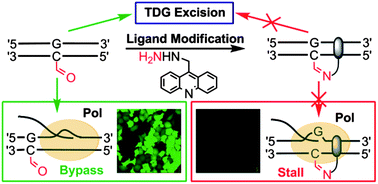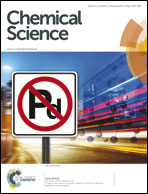A chemical probe targets DNA 5-formylcytosine sites and inhibits TDG excision, polymerases bypass, and gene expression†
Abstract
Dynamic regulation and faithful maintenance of proper DNA methylation patterns are essential for many cellular functions. 5-Formylcytosine (5fC), a newly discovered oxidized form of methylcytosine (mC), is involved in active DNA demethylation processes. The latest progress suggests exciting novel functional roles of this residue. Chemical tools are desired to further elucidate the functional roles of 5fC and to modulate dynamics of DNA demethylation and downstream biological processes. Here we designed and constructed a chemical probe, consisting of an aldehyde-targeting group and an intercalation group. This molecule can selectively react with 5fC and subsequently inhibit base excision by thymine DNA glycosylase (TDG) and cause significant pausing for both DNA and RNA polymerase elongation. Further investigation using a GFP reporter system in living cells revealed that the covalent modification in 5fC sites at 5′-UTR of the GFP gene greatly inhibited the GFP expression level. These results altogether confirmed our successful design and established a new approach for generating functional probes that target the formylcytosine sites and modulate 5fC-related biological processes.


 Please wait while we load your content...
Please wait while we load your content...